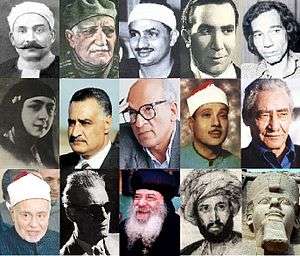Sa'idi people
|
Top row (left to right) Mustafa Lutfi el-Manfaluti • Abbas el-Akkad • Sheikh Mohamed Siddiq El-Minshawi • Youssef Wahbi • Amal Donkol Middle row (left to right) Hoda Shaarawi • Gamal Abdel Nasser • Gamal El-Ghitani • Abdulbasit Abdussamad • Abdel Rahman el-Abnudi Bottom row (left to right) Muhammad Sayyid Tantawy • Taha Hussein • Pope Shenouda III of Alexandria • Rifa'a el-Tahtawi • Ramesses II | |
| Total population | |
|---|---|
|
ca. 32 million (2008) 40% of Egypt's total population | |
| Regions with significant populations | |
| ca. 21 million (2008 estimate) | |
| Languages | |
| Sa'idi Arabic, Egyptian Arabic | |
| Religion | |
| Mainly: Islam, Coptic Orthodox Christianity and a very small minority of Bahá'ís.[1] | |
A Ṣa‘īdi (Arabic: صعيدى) is a person from Upper Egypt (Arabic: صعيد مصر Ṣa‘īd).[2] 40% of Egyptians live in Upper Egypt, and 80% of Egypt's poverty is concentrated in Upper Egypt.[3] Millions of upper Egyptians have migrated to Lower Egypt for work opportunities. The Sa'idi people are traditionally rural.
Etymology
The word literally means "from Ṣa‘īd" (i.e. Upper Egypt), and can also refer to a form of music originating there,[4] or to the dialect spoken by Sa'idis. The Arabic word Ṣa‘īd, as a geographical term, means "highland, upland, plateau".[5] The suffix "-i" denotes the adjective.
Pronunciation
The word Ṣa‘īdi is pronounced in the dialect itself as [sˤɑˈʕiːdi] or [sˤɑˈʕiːdej] and the plural is [sˤɑˈʕɑːjda] or [sˤɑˈʕɑːjde], while pronounced in Egyptian Arabic (Northern Egyptian) as [sˤeˈʕiːdi] and the plural is [sˤɑˈʕɑjdɑ].
Stereotypes and jokes
Ṣa‘īdis and their dialect are the subject of numerous Egyptian ethnic jokes. They are popularly assumed to be rural simpletons, physically stronger and less clever than other Egyptians. An example of such stereotyping is the box office hit Ṣa‘īdi fil-Gama‘a al-Amrikiya ("A Sa'idi in the American University", i.e. the American University in Cairo) (1998) starring Mohamed Henedi.[6]
Religion in Upper Egypt
The region has a large Coptic population and a rich Coptic history. For instance, Sahidic was the leading Coptic dialect in the pre-Islamic period. In the last few decades the high proportion of Copts in Upper Egypt has enabled some Christians to hold prominent political posts there. For instance, Qena Governorate had a Coptic governor in 2011.
See also
- Upper Egypt
- Sa'idi Arabic (the dialect spoken by Sa'idis)
References
- ↑ http://arabi.ahram.org.eg/arabi/Ahram/2009/5/9/Fron0.htm
- ↑ Abu-Lughod, Lila (2006). Local Contexts of Islamism in Popular Media. Amsterdam University Press. p. 24 pages. ISBN 90-5356-824-7.
- ↑ "Young People in Upper Egypt: New Voices, New Perspectives".
- ↑ Zuhur, Sherifa (2001). Colors of Enchantment. American University in Cairo Press. p. 456 pages. ISBN 977-424-607-1.
- ↑ Wehr, Hans, 1979. A Dictionary of Modern Written Arabic. Ithaca: Spoken Language Services Inc.
- ↑ Sa'eedi fil gamaa el amrekeia on IMDb
